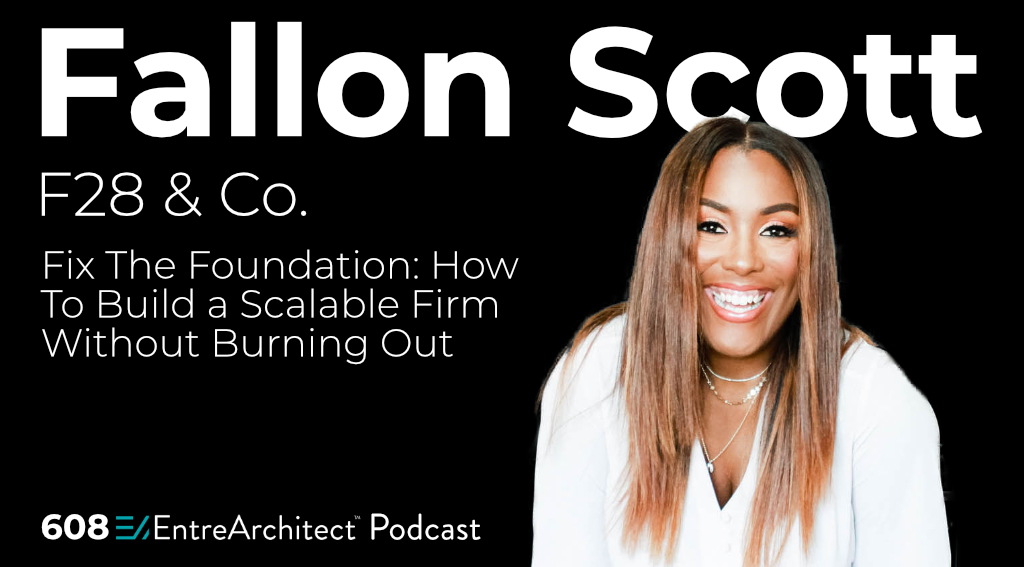
As small firm architects, we are trained and passionate about design. We love solving spatial problems and creating places where people can live, work, and thrive. But building a business—that’s a different kind of architecture altogether.
In this episode of EntreArchitect Podcast, I sat down with Fallon Scott, founder of F28 & Co., a strategic advisory firm focused on optimizing operations, improving profitability, and building sustainable businesses. Fallon’s background as a CPA and former auditor with experience at KPMG and Delta Airlines gives her a unique perspective on the inner workings of both global corporations and entrepreneurial ventures. And she’s on a mission to help small business owners—like us—implement the kinds of systems and strategies that allow a firm to grow without burning out.
Fallon brought deep insight to our conversation, and in this article, I’m sharing my top takeaways for architects who want to build smarter, more profitable firms. You can hear the full conversation at EntreArchitect.com/608.
From Big Four Accounting to Small Firm Strategy
Fallon’s origin story is one of transformation. She started out in “Big Four” public accounting, then moved to Delta Airlines where she helped launch their internal audit team. That’s where she discovered her passion for diagnosing problems and fixing operational gaps across large, complex systems. But the big revelation came when she realized she didn’t want to just report the problems—she wanted to solve them.
That led her to launch F28 & Co., where she now brings enterprise-level thinking to entrepreneurs who are deeply skilled in their craft but often missing the operational support they need to scale.
Sound familiar?
Most of us didn’t go to architecture school to become operations managers. But when you run a small firm, everything falls on you. Fallon calls it being “the fixer and the finder.” And she’s built her practice around helping small firms fix what’s broken and find a better way.
Why Small Firms Struggle (and Big Firms Still Have the Same Problems)
Here’s one of the most fascinating lessons Fallon shared: operational chaos doesn’t go away as you grow—it gets bigger.
She saw it firsthand at Delta, where different departments, teams, and global locations all had their own ways of doing things. The larger the organization, the more disconnected the systems became. You’d expect that from a tiny firm where everything lives in one or two people’s heads, but it’s shocking to see the same dysfunction at billion-dollar companies.
So Fallon made it her mission to reverse-engineer that growth pattern—to help small firms build a strong operational foundation before they scale. Because if you don’t, you’re just becoming a big business with small business problems on a massive scale.
Start with a Holistic Assessment
When Fallon begins work with a new client—whether it’s an architect, consultant, or creative entrepreneur—she doesn’t jump straight into solving the issue they called about. Instead, she starts with a full diagnostic.
She asks deep questions. She listens. And she assesses the firm across eight key categories:
- Sales & Marketing
- Tech, IT & Digital Systems
- Strategic Financial Management
- Legal, Risk & Compliance
- Operations & Process Optimization
- People & Organizational Development
- Growth & Capital Access
- Succession & Exit Planning
That framework reveals patterns and connections that firm owners often can’t see. Maybe you think you have a sales problem, but Fallon finds that the root cause is operational—your delivery system can’t scale with your current staffing or structure. Maybe you’re struggling to hire, but the real issue is a lack of SOPs and onboarding systems.
Fallon’s approach is to trace the ripple effects across functions and pinpoint the few key moves that could trigger big positive change.
Why SOPs Are Your Secret Weapon
Of all the operational weaknesses Fallon sees, the absence of Standard Operating Procedures (SOPs) is the most common—and most costly.
It may not be glamorous, but it’s essential. SOPs allow you to delegate, onboard, and ensure consistency across your client experience. Fallon compares it to Chick-fil-A: the ability to deliver the same service every time, regardless of who’s working that day, comes down to process.
The pushback she hears most often? “I don’t have time.”
Her response? Use tools like Loom to record your screen and narrate as you work. Loom’s new AI functionality will even generate draft SOPs from your videos. Just record your process, upload it, and let the system do the initial heavy lifting.
You don’t need to perfect it all at once—Fallon reminds us that SOPs are editable. Start somewhere. Start now.
Don’t Leave Money on the Table
Another theme Fallon is passionate about: small businesses are constantly missing out on money they’ve already earned—or money they could access to fund their growth.
Whether it’s:
- Over-hiring without a clear revenue model
- Missing R&D tax credits or 179D deductions
- Structuring your finances to reduce taxes but undermining your eligibility for funding or valuation
…it all adds up.
Fallon’s firm is built to help small business owners avoid those pitfalls by thinking more strategically about their financials. If you’re showing losses on your tax return to save money short-term, you might be hurting your long-term potential to sell or raise capital.
She even recommends working with partners who specialize in identifying “add-backs”—non-recurring expenses that can be added back into your income to increase the value of your firm during a sale or acquisition.
This isn’t just about accounting. It’s about designing your firm with intention.
Track These Two Metrics First
If you don’t track any metrics in your business today, Fallon says there are two to start with:
- Conversion Rate – From leads to signed projects. Where are your leads coming from? How are they converting? What’s working?
- Client Satisfaction + Referral Generation – Did you deliver what you promised? Are your past clients sending you more business?
These two metrics cover the front and back of the customer journey. If you know how to bring clients in and you know how to make them happy enough to become your best marketers, you’re on a strong foundation.
Start With This One Thing
So what’s the first step?
Fallon’s advice is simple and clear: get an assessment. Whether it’s with her team or someone else you trust, get outside eyes on your business. You can’t fix what you don’t know is broken. Once you have that 30,000-foot view, you can prioritize what to tackle first.
If you want to work with Fallon, you can take her firm’s business assessment or schedule a consult at F28co.com. Be sure to let her know you’re coming from the EntreArchitect community.
Fallon’s story is a reminder that there’s nothing small about running a small firm. And you don’t have to do it alone. The tools, systems, and support you need to scale with sanity do exist—you just need a guide to help you put the pieces together.
If this conversation inspired you or you want to dig deeper into Fallon’s framework, listen to the full episode at EntreArchitect.com/608. Your future business—and your future self—will thank you.

Leave a Reply